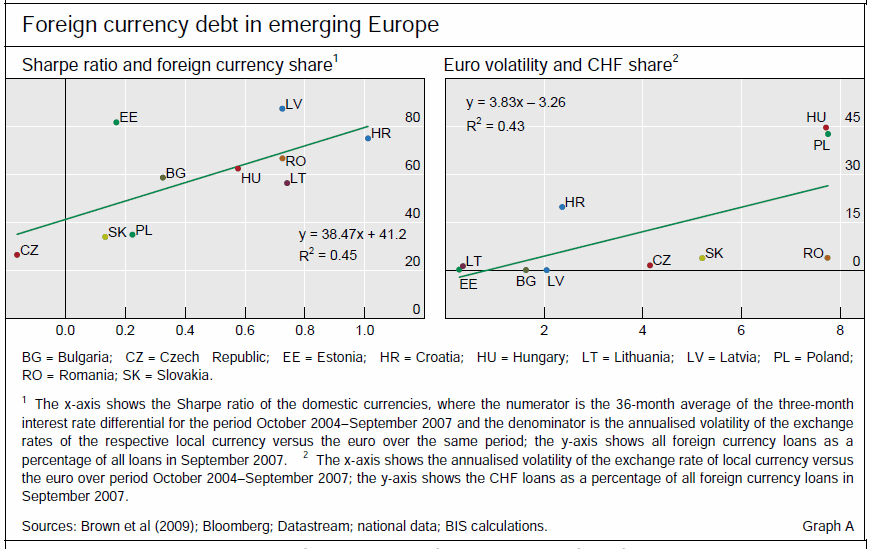Foreign currency borrowing in emerging Europe: households as carry traders
(Extract from pages 18-19 of BIS Quarterly Review, September 2010)
Currency weakness in central and eastern Europe during the crisis highlighted the risk of foreign currency debt. Such debt can hedge exporters' cash flows. But households without foreign currency income can struggle with sudden hikes in the cost of servicing foreign currency mortgages.
We find first that foreign currency lending in emerging Europe was larger than previously thought. Second, the extent of foreign currency borrowed in each country depended on the ratio of interest savings to currency volatility. Moreover, the same perspective can also explain why debtors in some countries borrowed mostly in euros while debtors in other countries borrowed more in Swiss francs. Thus, interest rate and exchange rate policies shaped the demand for foreign currency debt. The supply side adapted: Swedish banks lent euros in the Baltics, while affiliates of German, Italian and US banks, not Swiss banks, lent Swiss francs in Poland and Hungary.
How large was foreign currency lending in emerging Europe?
Emerging Europe had borrowed more in foreign currency by the third quarter of 2007 than has been appreciated. Including cross-border loans booked elsewhere in Europe reported to the BIS, the foreign currency share of loans had in aggregate reached about one half. It ranged from a quarter (Czech Republic) to almost 90% (Latvia). These shares are all higher than one observes in loans booked domestically in central and eastern Europe.1 While this phenomenon is often called euroisation, Swiss franc loans represented about 20% of foreign currency loans.
What accounts for the differences across countries in the share of foreign loans? The next section provides a partial answer to this question.
Households and firms as carry traders
The extent of foreign currency lending in emerging Europe can be understood to a large extent from the demand side. Private borrowers in these economies traded off the interest savings of foreign currency borrowing against the risk of having one's debt ratchet up in terms of domestic currency. Given interest rates in the euro and Swiss franc, this trade-off reflected policy differences across emerging Europe, both in the setting of interest rates and in the management of currencies.
One can think of households and firms in these economies as analogous to carry traders. Carry traders accept principal risk on their position in exchange for receiving net interest receipts ("positive carry"). Similarly, households and firms in the region accept principal risk on their mortgages or corporate loans, as translated into domestic currency, in exchange for lower interest rates. The trade-off between carry and risk for foreign currency borrowers is captured by the Sharpe ratio, which divides the interest savings in per cent by the volatility of the relevant exchange rate, also in per cent. The higher the ratio, the more attractive the position.
in per cent. The higher the ratio, the more attractive the position. It is easy to see why there might be interest savings from denominating debts in euros or Swiss francs. Central and eastern European economies are catching up with their counterparts in western Europe, and so productivity is rising rapidly in the traded goods sector (eg auto production). If productivity improves less in services (eg haircuts), then the relative cost of services rises faster during the catch-up. Since traded goods tend to be priced similarly in an integrated market, this implies that inflation is higher in the country catching up, calling for higher policy interest rates.2
In fact, interest rates in central and eastern Europe have tended to be higher than in the euro area in recent years. Only in the Czech Republic have short-term interest rates tended to be lower than their counterparts in the euro area. Interest rates were even lower on Swiss franc borrowing.
A lower interest rate, the gain, had to be weighed against the potential pain of debt service rising in terms of the domestic currency. Some authorities managed their currencies tightly against the euro, but others allowed more movement. We measure the extent to which the exchange rate against the euro actually moved over the period from October 2004 to September 2007. The volatility - measured by the annualised standard deviation of daily percentage changes - of the domestic currency against the euro ranged from 0-2% in the Baltics, Bulgaria and Croatia to almost 8% in Hungary, Poland and Romania. A wide interest rate differential and low volatility (a high Sharpe ratio) favoured foreign currency borrowing, while a narrow interest rate differential and high volatility discouraged foreign currency borrowing.
Sharpe ratios and the choice
One can divide the decision-making into two steps. Households and firms first assess the attractiveness of the interest saving from euro-denominated debt in relation to the volatility of the domestic currency against the euro. For each currency, the average three-month interest differential between the euro and the domestic currency in October 2004-September 2007 is divided by the volatility of the bilateral exchange rate between the euro and the local currency. When this ratio is plotted against the share of foreign currency borrowing, countries with higher Sharpe ratios show higher fractions of foreign currency debt. The Sharpe ratio alone accounts for over 40% of the crosssectional variation in such borrowing in the region (Graph A, left-hand panel).3
The next step is to account for the choice of denomination of the foreign currency lending. In terms of the interest rate, there would be the same 1½% saving on a franc vis-à-vis a euro loan anywhere from the Baltics to Bulgaria. However, the exchange rate volatility would look very different from the various perspectives in the region. Where the local currency tracked the euro closely, the volatility of the Swiss franc versus the euro would make franc borrowing less attractive. Where, as in Hungary and Poland, the domestic currency fluctuated considerably against the euro, there was little incremental volatility to borrowing in the Swiss franc to offset the interest saving. The 1½% lower interest rate looked good when compared to the ⅓% (in Poland) or ¾% (in Hungary) additional volatility of Swiss franc debt, and in those countries its share is highest (Graph A, righthand panel). Ironically, currency flexibility encouraged Swiss franc debt, which has proven painful to obligors given the 20% rise of the Swiss franc/euro rate from September 2007 to August 2010.
1 Cross-border loans reported to the BIS represented about 19% of the domestically booked loans that are reported by M Brown, M Peter and S Wehrmüller, "Swiss franc lending in Europe", Aussenwirtschaft, no 64(2), 2009, pp 167-81.
2 This assumes stable nominal exchange rates; see D Mihaljek and M Klau, "Catching-up and inflation in transition economies: the Balassa-Samuelson effect revisited", BIS Working Papers, no 270, December 2008.
3M Brzoza-Brzezina, T Chmielewski and J Niedźwiedzińska, "Substitution between domestic and foreign currency loans in Central Europe. Do central banks matter?", ECB Working Paper Series, no 1187, May 2010, show that foreign currency debt responds to Czech, Hungarian, Polish and Slovak interest rates.


